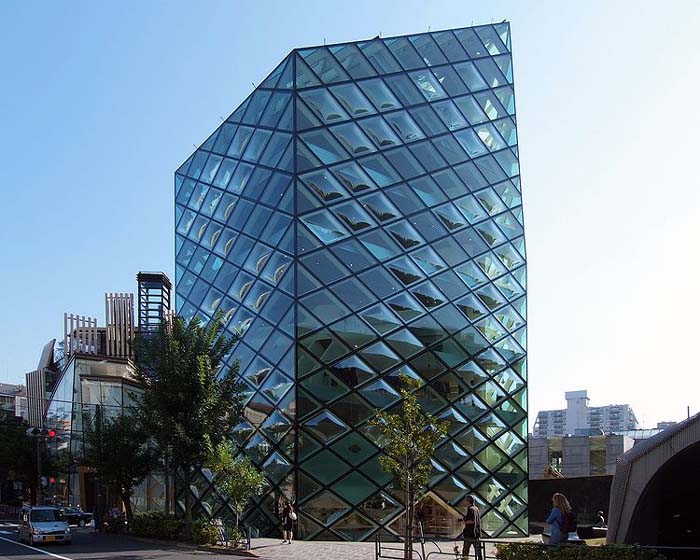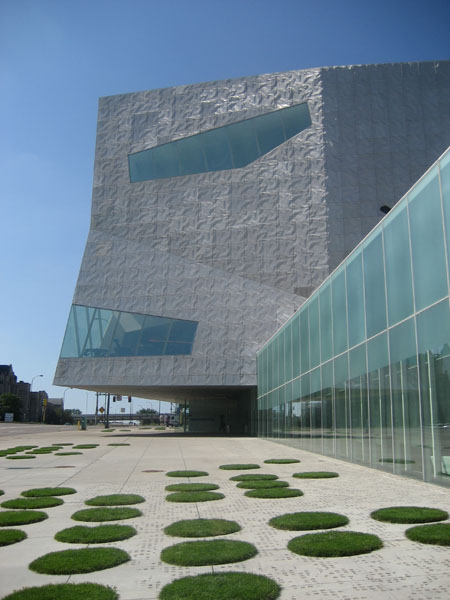 |
New York Architecture Images-New York Architects Herzog &De Mueron |
 |
|
|
Prada Store in Tokyo. |
|
 |
|
| Walker Art Center, Minneapolis, Minnesota. | |
|
At a time when architecture is known for its decorators and
sensation-seeking stunt men, Herzog & de Meuron stand apart as truly
formidable innovators. They create buildings of extraordinary
imagination, exploiting new technologies to the fullest while at the
same time deeply respecting the eternal values of building. Their work
continually pushes the envelope of the possible, while never losing
sight of the building’s function and identity. Herzog & de Meuron have been friends since childhood. They attended architecture school together and more than 20 years ago formed a professional partnership. They are known for a long run of spectacular achievements including the Olympic Stadium in Beijing, the Tate Modern at Bankside, London; Prada’s Tokyo store; the extension of the Walker Art Museum, Minneapolis; the new De Young Museum, San Francisco; and the new MOMA roof garden. In 2001 they became the first team to win the Pritzker Prize, generally considered the Nobel Prize of architecture. Pritzker juror Carlos Jimenez wrote, "One of the most compelling aspects of work by Herzog & de Meuron is its capacity to astonish. They are able to transform what might otherwise be an ordinary shape, condition or material, into something truly extraordinary. Jacques Herzog has compares their work to that of artist Andy Warhol: "He used common Pop images to say something new. That is exactly what we are interested in: to use well known forms and materials in a new way so that they become alive again ... We love to destroy the clichés of architecture… The strength of our buildings is the immediate, visceral impact they have on a visitor." Herzog says of 40 Bond Street: "We like radical positions and we try to offer them. The idea of gates came to us first. It gave us a signature, a scale and an individuality. The gates introduce the scale of the townhouses. The question was what kind of structure or grid or image would they have on them. We tested different things and most of them looked too traditional but we then came up with the idea of something very chaotic which we thought could be seen as coming from urban street culture, where graffiti is part of the landscape. So we took graffiti and manipulated it on the computer, the result is radical but it was a classical process of transformation." The extraordinary building began with a copied sample of the work of an anonymous human hand, a “wild style” script created on the fly with the magic marker, and it transformed it into a building for the ages. Transformation is the essence of Herzog & de Meuron’s aesthetic and process. In 40 Bond Street they have created a building that draws tremendous energy and form from its surrounding buildings and even the environment of the street, transforming not just our ideas of a residential building, but how we live. -------------------- Herzog & de Meuron Basel Ltd., or Herzog & de Meuron Architekten, BSA/SIA/ETH (HdM), is a Swiss architecture firm with its head office in Basel, Switzerland. The careers of founders and senior partners Jacques Herzog (born 19 April 1950), and Pierre de Meuron (born 8 May 1950), closely paralleled one another, with both attending the Swiss Federal Institute of Technology (ETH) in Zürich. They are perhaps best known for their conversion of the giant Bankside Power Station in London to the new home of Tate Modern. Jacques Herzog and Pierre de Meuron have been visiting professors at the Harvard University Graduate School of Design since 1994 and professors at ETH Zürich since 1999. The firm was founded in Basel in 1978. In 2001, Herzog & de Meuron were awarded the Pritzker Prize, the highest of honours in architecture. Jury chairman J. Carter Brown commented, "One is hard put to think of any architects in history that have addressed the integument of architecture with greater imagination and virtuosity." This was in reference to HdM's innovative use of exterior materials and treatments, such as silkscreened glass. Architecture critic and Pritzker juror Ada Louise Huxtable summarized HdM's approach concisely: "They refine the traditions of modernism to elemental simplicity, while transforming materials and surfaces through the exploration of new treatments and techniques." In 2006, the New York Times Magazine called them "one of the most admired architecture firms in the world." HdM's early works were reductivist pieces of modernity that registered on the same level as the minimalist art of Donald Judd. However, their recent work at Prada Tokyo, the Barcelona Forum Building and the Beijing National Stadium for the 2008 Olympic Games, suggest a changing attitude. HdM's commitment of articulation through materiality is a common thread through all their projects. Their formal gestures have generally progressed from the purist simplicity of rectangular forms to more complex and dynamic geometries. The architects often cite Joseph Beuys as an enduring artistic inspiration and collaborate with different artists on each architectural project. Their success can be attributed to their skills in revealing unfamiliar or unknown relationships by utilizing innovative materials. |
|
|
links |
|